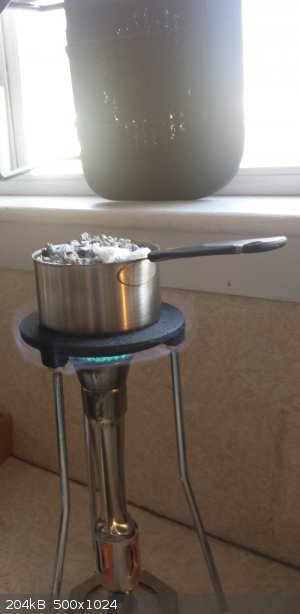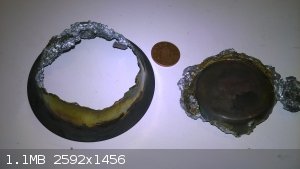agent_entropy
Hazard to Self
 
Posts: 91
Registered: 17-7-2006
Location: U.S.
Member Is Offline
Mood: No Mood
|
|
Flux for zinc smelting?
I recently acquired a large quantity of zinc dust (on the order of kilograms, particle size less than 125 um (115 mesh)) and after playing about with
the obvious pyrotechnic and reductive uses, I endeavored to melt some of it in order to make some castings.
However, I encountered a problem when attempting to melt it. I loaded some of the powder into a stainless steel crucible, covered it with a watch
glass, and heated it with a MAP gas torch. The powder does not melt. I hypothesize that the oxide coating on the particles is acting as a skin which
contains the molten zinc within the particle and thus prevents the molten zinc phases from mixing. I have tried stirring with a steel rod to try to
disrupt the zinc "bubbles" but this requires removing the watch glass and as soon as it is removed the zinc bursts into flames.
Can anyone recommend a flux that might help with melting into a contiguous phase of liquid zinc? Or, alternatively, a technique that would work for
such an application?
|
|
|
Detonationology
Hazard to Others
  
Posts: 362
Registered: 5-5-2015
Location: Deep South
Member Is Offline
Mood: Electrophillic
|
|
Powders cannot be easily melted. I've produced some Bismuth powder from a reaction using Pepto-Bismol, and I've never been able to melt the powder.
The problem is that it just has too much surface area in contact with the air. You will need a foundry furnace or something, but zinc powder is
pretty precious, expensive stuff. If you want to cast some zinc, just melt down a couple dollars worth of post-1986 (IIRC) pennies.
[Edited on 10-16-2015 by Detonationology]
“There are no differences but differences of degree between different degrees of difference and no difference.” ― William James
|
|
|
MrHomeScientist
International Hazard
    
Posts: 1806
Registered: 24-10-2010
Location: Flerovium
Member Is Offline
Mood: No Mood
|
|
Or melt down boat anodes - the local marine store is my source for OTC zinc.
I've also had the same problem with Bi powder. Probably an inert atmosphere is required for melting such fine powders. Or perhaps a suitable
high-boiling inert liquid (mineral oil?) to cover the power and exclude oxygen.
|
|
|
elementcollector1
International Hazard
    
Posts: 2684
Registered: 28-12-2011
Location: The Known Universe
Member Is Offline
Mood: Molten
|
|
I had similar troubles with cadmium powder from NiCd batteries. This was eventually solved by a flux of NaOH (or KOH, I don't remember - point was, it
didn't react appreciably) and melting copious amounts of powder at a time, leaving me with two small cadmium 'pebbles' (the new favorite breakfast
cereal).
Elements Collected:52/87
Latest Acquired: Cl
Next in Line: Nd
|
|
|
sbreheny
Hazard to Others
  
Posts: 145
Registered: 30-1-2014
Member Is Offline
Mood: No Mood
|
|
Your analysis of the problem (oxide coating acting as a skin) is exactly right in my experience. About 8 months ago, I cast a V-block out of zinc (see
attached photo) which I then drilled and tapped to make a custom mounting bracket. It took me several attempts. I found the ammonium chloride works
very well as a flux. I have a few tips/cautions for you:
1) If your zinc is catching fire on contact with air, you are getting it way too hot. I did this too at first because it didn't seem to be melting, so
I heated it further. I nearly had a disaster when the super hot molten zinc worked its way through the wall of the container I was heating it in and
blobs of flaming metal began pouring out, turning to white zinc oxide as they fell, making pretty blue-white flames.
2) Molten zinc doesn't have a very high vapor pressure at close to its melting point but I would still recommend ventilation. If you heat it
considerably above the melting point then you may get metal fume fever from inhaling zinc vapor and zinc oxide dust. This is not usually serious but
from what I've heard it is nasty for a day or two (flu-like symptoms)
3) Use extra zinc beyond what you need. Mix in a liberal amount of ammonium chloride. You will end up with quite a bit of dross on the surface of the
melt which you will need to spoon-off before pouring.
4) Beware that ammonium chloride will decompose into ammonia (NH3) and hydrochloric acid vapor when heated. This will require very good ventilation
like being outdoors or in a fume hood.
Sean

|
|
|
sbreheny
Hazard to Others
  
Posts: 145
Registered: 30-1-2014
Member Is Offline
Mood: No Mood
|
|
Additional photo and info - I found that I had to cover the entire surface of the metal in the pot with about a 2 or 3 mm layer of NH4Cl and then I
think I added more part-way through the melting. The black thing in the background is an exhaust fan in an open window, right next to the melting pot.
That's a Meker burner using propane.

|
|
|
unionised
International Hazard
    
Posts: 5102
Registered: 1-11-2003
Location: UK
Member Is Offline
Mood: No Mood
|
|
It's reasonable to say that the problem is the oxide on the zinc.
Why not ad carbon and reduce it?
|
|
|
kadriver
Hazard to Others
  
Posts: 196
Registered: 7-11-2012
Location: United States
Member Is Offline
Mood: Thankful
|
|
Sugar?
|
|
|
Fulmen
International Hazard
    
Posts: 1693
Registered: 24-9-2005
Member Is Offline
Mood: Bored
|
|
For lead casting paraffin wax is often employed. Some claim it can reduce the oxides back to metal, but I suspect that it will be a pretty slow
reaction (if at all). The main function I can see is to break the adhesion between the metal and it's oxides. It seems to wet the dross while not the
metal, allowing it to separate out on top.
We're not banging rocks together here. We know how to put a man back together.
|
|
|
agent_entropy
Hazard to Self
 
Posts: 91
Registered: 17-7-2006
Location: U.S.
Member Is Offline
Mood: No Mood
|
|
Thanks sbreheny. I had considered ammonium chloride, but dismissed the idea since it decomposes with heat. But if you were able to use it
successfully perhaps I'll give it a try.
|
|
|
Mesa
Hazard to Others
  
Posts: 264
Registered: 2-7-2013
Member Is Offline
Mood: No Mood
|
|
Ammonium zinc chloride or diammonium tetrachlorozincate(-2) which is prepared from mixing aqueous solutions with various proportions of the required
ions(Bubbling NH3 into ZnCl2 solution for example.) is used as a galvanic flux. Would it be more applicable here than NH4Cl? Or would ammonium
chloride decomposition on Zn surface act in the same manner anyways?
|
|
|
nlegaux
Hazard to Self
 
Posts: 93
Registered: 28-11-2014
Location: East Tennessee
Member Is Offline
Mood: No Mood
|
|
Sorry if I am derailing the intended subject of this thread, but what did you do to isolate the Cd from the batteries elementcollector1?
nlegaux
|
|
|
elementcollector1
International Hazard
    
Posts: 2684
Registered: 28-12-2011
Location: The Known Universe
Member Is Offline
Mood: Molten
|
|
Quote: Originally posted by nlegaux  | Sorry if I am derailing the intended subject of this thread, but what did you do to isolate the Cd from the batteries elementcollector1?
nlegaux |
Took apart the battery, gathered up the gray cadmium powder from the cathode(?), placed it all in a crucible under a small amount of NaOH, and heated
on a hotplate. No real chemistry required, but it was a fun little project.
On a side note, would it be possible to press the Zn powder in order to make melting easier?
Elements Collected:52/87
Latest Acquired: Cl
Next in Line: Nd
|
|
|
unionised
International Hazard
    
Posts: 5102
Registered: 1-11-2003
Location: UK
Member Is Offline
Mood: No Mood
|
|
Yes love?
(I bet that joke doesn't work internationally)
I have used sugar to reduce lead oxide. It works, but it stinks. The fumes sting your eyes.
|
|
|
JJay
International Hazard
    
Posts: 3440
Registered: 15-10-2015
Member Is Offline
|
|
Aluminum chloride is sometimes used as a flux, but it has to be anhydrous or it will decompose. I think zinc chloride can be used as a flux too....
|
|
|
wg48
National Hazard
   
Posts: 821
Registered: 21-11-2015
Member Is Offline
Mood: No Mood
|
|
You can use a 50:50 mixture of sodium chloride and potassium chloride. It melting point is bit high at about 650C but its easily available as low
sodium substitute for table salt. For example So-Low.
I suggest caution when using it with a powder incase it has thermite properties. Also the molten zinc will wet stainless steel in the presence of a
flux and can rapidly dissolve/degrade it. Possibly steel crucibles too. See the effect it had on my nonmagnetic stainless steel crucible in the pic
below.

|
|
|
alive&kickin
Hazard to Others
  
Posts: 100
Registered: 10-11-2012
Member Is Offline
Mood: No Mood
|
|
I can second that of Fulmen. I've also cast lead and wax works great, cut up some candles and was good to go. I'm not so sure it would work with
zinc but maybe worth an easy, quick, and cheap small scale try. to unionised, works on this side of the pond.
|
|
|
highpower48
Hazard to Self
 
Posts: 98
Registered: 30-10-2014
Member Is Offline
Mood: No Mood
|
|
I would make up small amounts, say 8oz and 1# or so and sell it here or on ebay. I would take a pound. I use zinc tire weights I get when buying
lead tire weights there are always zinc weights mixed in. They are no problem to melt and case....
|
|
|